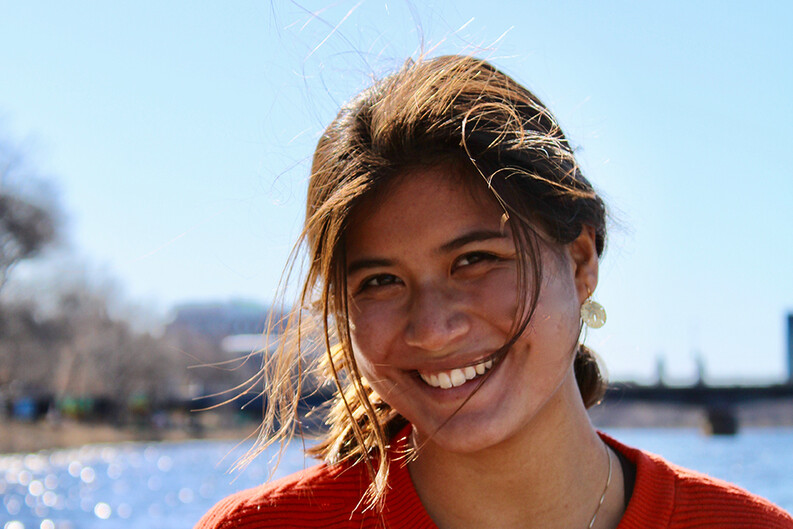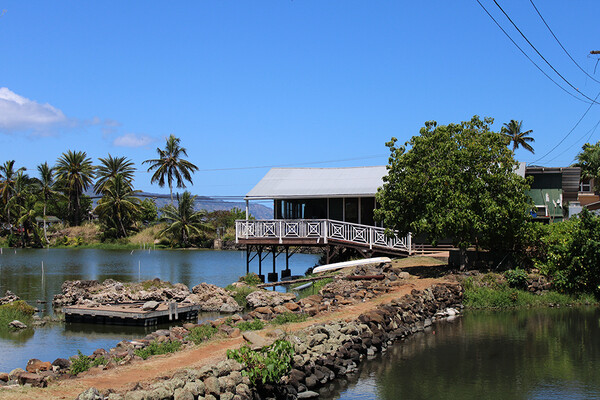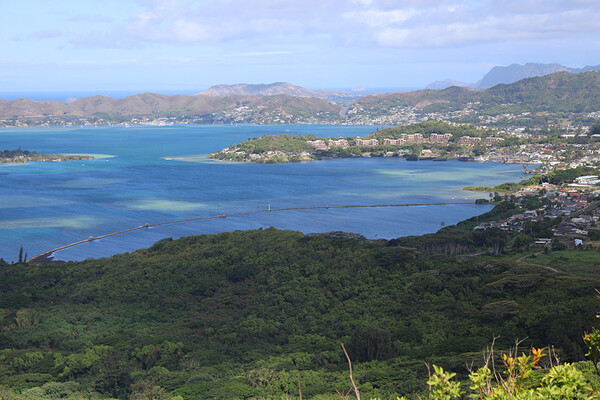Q&A: LEAP Grant Recipient Grace Cajski

Grace Cajski YC ’24 is a Law, Ethics & Animals Program (LEAP) student grant recipient and an environmental studies major at Yale College. Last summer, as part of her LEAP student grant, she traveled to O‘ahu to profile an aquaculture restoration movement reviving ancient Hawai‘ian fishponds. Her project, Talking Story4, chronicles the challenges and importance of their mission. Cajski’s reporting has already appeared in ECO Magazine5, the Yale Program on Climate Change Communication blog6, and other outlets7, and transcripts from her interviews with kupuna (Hawai‘ian elders) will soon be available as part of the University of Manoa’s Center for Oral History. LEAP Program Fellow Noah Macey spoke to Cajski about Hawai‘ian aquaculture and her experience reporting on it.
Could you describe the basics of Hawai‘ian aquaculture?
I can start by describing the ancient land management system, which was called the ahupua‘a system. Each island is pretty much a circle. The ancient Hawai‘ians divided the circle into pie-shaped segments starting where a mountain would catch a cloud. Rain would fall down. It trickled through the forest and percolated down through the mountain, running through the village, et cetera, until it flowed out to the sea. So you have this triangular watershed area that’s one land management unit, or ahupua‘a, and at the base of it there’s a fish pond. That’s right where freshwater meets seawater, which is where all the major macronutrients, N, P, & K (Nitrogen, Phosphorous, and Potassium) are present. Estuaries are already big nursery areas for animals, and the ancient Hawai‘ian noticed this. They also noticed that some of their key herbivorous fish species are catadromous, meaning that they spend their life in these estuary areas and go out to sea to spawn, then come back to the estuary.
They learned that if they could fence this area in, they could keep these fish — they would grow large and be unable to swim out. The premise was to leverage these natural processes of fresh water coming down from the mountains and fish swimming into the pond from the sea to create what people call an “artificial estuary,” or “living refrigerator.”

Here’s some Hawai‘ian terminology: the muliwai is the estuary area. A kuapā, is a dry-stacked lava rock wall — these are vulnerable to being knocked down by king tides nowadays because of climate change, but being dry-stacked is important to the system: it allows for the inflow of nutrients and water from the sea. Within the kuapā, there are mākāhā, sluice gates, and that’s what allows the fish to come in when they’re open.
One way to harvest the fish is to fish them from the pond. Or, in the winter, when the fish — the mullet, specifically — go out to spawn, they’ll crowd up against the mākāhā, and you can catch them with a big net. That’s the major catch of the year. When Chinese immigrants arrived in Hawai‘i, they added a double mākāhā to the ponds, which is common practice these days — there used to be a single one, but now people use two. This way you can lift one, the first one that’s closer to the inside of the pond, and the fish will try to swim out to the ocean. Then you drop the gate back in place once they pass through, and now they’re all stuck in this little mini canal to be caught. It’s pretty ingenious.
Once you arrived in Hawai‘i, how did you get started learning about these Hawai‘ian aquaculture systems?
I was interested in the idea of restorative aquaculture: how can growing seaweed or striped mullet in fishponds help restore the surrounding shore environment? So I set about talking to different people in fishpond community — I spoke with scientists, conservationists, fishpond caretakers, docents at the fish ponds, people who grew up keeping fishponds. So, that’s how I spent the majority of my time in Hawai‘i: interviewing people and talking to them, getting lunch with them.
Some days involved more hands-on stuff, like a community workday at Heʻeia pond helping to remove some mangroves, so I could see what the process of restoring a fish pond looks like. Another day I went to pauhana time, which is an end-of-workweek celebration, at Waikalua Loko. There was a tour around the pond, we sang some songs and ate good food. So those were average hands-on days.
After each interview I’d take some time to transcribe them, and I’d send some of the transcriptions to the Center for Oral History.
You write quite a bit about what it’s like for these activists and elders to rebuild these fishponds that have fallen into disrepair. Could you talk about what restoring the fishponds is like? How do the aquaculturists renew the practice and make it work in modern ecosystems?
It’s important to understand that the ancient Hawai‘ians had an oral history. They shared knowledge verbally. And taking care of fishponds is an art; it’s the same kind of thing as woodworking. You need to use your hands, and you need to learn on site, and you need to learn from somebody. It’s not something you can learn from a book.
So when colonists came in and changed these land management practices, it destroyed a lot of knowledge. They dredged many of the ponds and filled them in to create more land for development. So the largest fish pond on O‘ahu, Kuapā Pond, was completely filled in by this guy — I think his name was Henry Kaiser—for land development. That was a massively productive fish pond, and it is lost. Waikiki was another fertile estuarine area that got completely developed. That means a huge fraction of this knowledge has been lost: a lot of people talked to me about a break between generations. That makes it really, really difficult to “restore” these ponds, because even what our parents tell us, even what our grandparents tell us, won’t contain enough information. It’s difficult to understand what the aquaculturists are restoring them to.
But some things are clear: there are efforts to remove invasive species like mangroves, to try to dredge the ponds. But they’re still not quite sure what exactly they looked like, which can make it difficult. It’s interesting—you hear little whispers from aquaculture proponents about “what used to be,” and it all sounds very mythological.
Despite all those challenges, you talk about how many ponds have found success growing new species and adapting to modern challenges. Could you talk about the challenges they’ve overcome that ancient Hawai‘ians wouldn’t have faced?
There’s all sorts of invasive species. In terms of fish, there’s the invasive kanda, which is a type of mullet. Another variety, the striped mullet, is a prized fish. But the striped mullet fishery, at least on O‘ahu, is completely decimated. It’s alarming that there’s no more commercial fishery because that fish has a lot of cultural importance to it. People grew up eating it, and now they aren’t able to share that with their children. So that’s something that a lot of fish ponds want to grow. But the kanda is in the way, along with some other invasives like Tilapia and the toʻau. Those are difficult for ponds to get rid of—you just have to fish them out.
The caretakers also talk about dredging the ponds because a lot of sediment has accumulated. They say the ancient Hawai‘ians would take logs and roll them around the bottom of the pond to disrupt the sediment and flush it out during high tide. But generations have passed where they haven’t been doing that, so there are ponds that are maybe just a foot deep that aren’t able to grow food. Many kuapā have also fallen down, and climate change means they have to build them back up even higher. The mākāhā have also deteriorated.

There’s contention within the fish pond communities about how many new things to add, especially as part of the restoration process. How much innovation and adaptation do you make to the ancient ways in response to climate change and reduced freshwater flow from land management practices? It’s a balance between restoring the traditional and innovating for the modern day.
One last difficulty has been permitting. A person who’s been a real game changer there is Walter Ritte — he’s an activist, the one who really started going in for this restoration work. It was so difficult for him to get permits at the beginning. Once, he told me that he couldn’t get a permit for a fish pond because if water overcomes the kuapā part, the pond technically becomes part of the ocean, and therefore a navigable waterway, which requires a whole different set of permits. Then, if the ponds are designated as local historic sites, you can’t really mess around with anything or restore the pond—he had to find a way to get around that as well. Thanks to his work, they compiled all the permits into one big restoration exception, so that’s now relatively resolved.
Another major issue is funding — a lot of people think it would be awesome if fishponds could make their own money, be self-sustaining, and stop relying on grants, but that’s not possible right now because they’re not growing fish at scale. So they’re looking for grants, but whoever gives out those grants gets to determine what the pond does. And there’s not a lot of grants for aquaculture production, but there are a lot of grants for education. So a lot of fishponds have turned towards cultural education.
How did you come to be interested in this topic? How did you come to learn about Hawai‘ian aquaculture revitalization?
My father grew up on O‘ahu, and I would go visit family there every year. One of my dad’s neighbors, who lived next to my grandparents’ house and who was my dad’s childhood best friend’s stepfather — he is a phycologist, an algae scientist. And he fell into this world — he worked for the Oceanic Institute, which is a nonprofit associated with Hawaii Pacific University, to do striped mullet stock enhancement, which then developed into work with the fish ponds.
And he kept doing aquaculture work. He even helped with fishponds in Egypt — he was completely in the fishpond world. Eventually he wrote this amazing book called The Keeper of Moliʻi Pond8 — that pond has adapted to modern conditions by growing oysters. The book is about one of the last traditional fishpond caretakers and his attempts to rediscover traditional methods. Uncle Vernon — that’s his name — wound up staying close to this aquaculturist, and we would go over to the pond to go fishing on our visits to O‘ahu, which was a special privilege.
When COVID happened, I had this interest in marine conservation and thought this project would be a good opportunity to learn a bit more about this work. Once I got involved, I found myself in this really insane community. I can’t explain to you the amount of obsession and passion, and I got completely absorbed into this world as well. It’s awesome.
So that’s how I started reporting — Uncle Vernon connected me with a bunch of people, and it became clear once I started speaking with them that it was so important to write this knowledge down. So much had already been lost before, and it’s important that we celebrate the conservationists’ work because so few people know about it. They’re not doing this for money: they’re doing it to see the fishponds flourish, and it’s important that we appreciate them for it.


